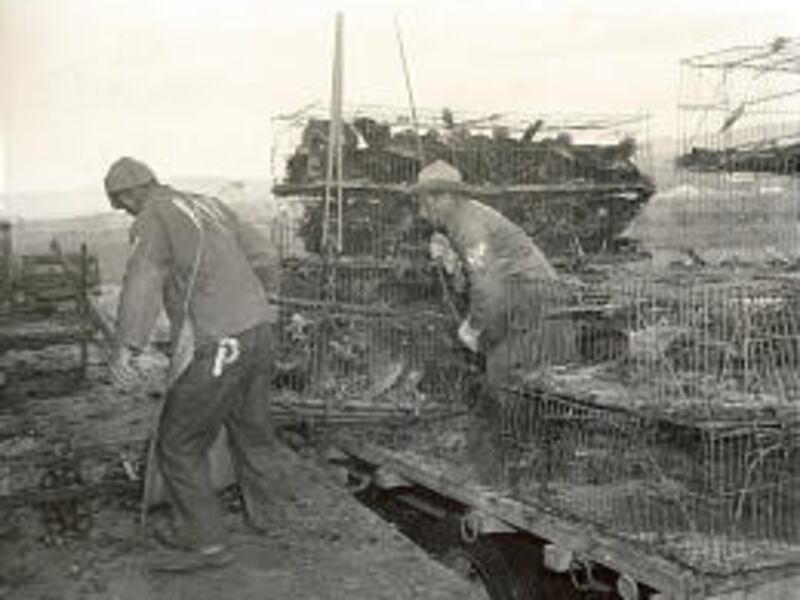OGDEN — The pictures show men in orchards and on turkey farms, a white "PW" stamped on the backs of their clothes. Life for the 15,000 Italian and German prisoners of war sent to Utah during World War II was at once confining and ordinary, a contrast apparent in a new photographic exhibit at Weber State University's Stewart Library.
The exhibit opens Wednesday in conjunction with "Building America's Defense: 1939-1975," the fifth annual Utah Construction/Utah International Symposium at WSU.
The black and white images of Italian and German POWs are also a vivid contrast to current news reports of POWs held in the U.S. war against terrorism. In the World War II photos, the men are shown taking communion at Catholic services, plowing fields, and playing in a band at a Christmas dance.
Although Utah was one of only two states that took prisoners of war during World War I, nearly every state in the country housed POWs during World War II. In Utah, the POWs were sent to military installations in Ogden, Hill Field, Fort Douglas and Tooele; the Germans were also sent to satellite camps to work with local farmers in Logan, Orem and Salina.
The first wave of about 1,000 Italian prisoners of war arrived by boxcar in Ogden in the spring of 1943. Over the next year their ranks swelled to nearly 5,000, all stationed in barracks built north of the warehouses of the Utah Army Service Forces Depot, later renamed the Defense Depot of Ogden.
When Italy surrendered in September of 1943, the Italian POWs were no longer classified as enemy prisoners of war and were offered the option of joining the Italian Service Unit, where they could work for 80 cents a day and enjoyed more freedom to form musical groups and play sports. Most, but not all, signed up for the ISU; those that didn't remained POWs and were sent to more isolated camps.
The first shipment of German prisoners arrived in the summer of 1944. At first, says historian Kent Powell of the Utah State Historical Society, there was some suspicion in the smaller communities that housed the POWs. But the suspicion often softened, Powell says, offering this quote from his book "Splinters of a Nation: German Prisoners of War in Utah."
The quote comes from farmer Delbert Olsen of Logan, whose 3-year-old daughter met one of the prisoners: "I noticed that one of these men had her in his arms and it gave me a fright," Olsen said. "I walked over to him and took the little girl by the hand and he didn't want to let her go. I could see the tears running down his face. The guard came running over. I don't know what he intended to do and I said to him 'Don't hurt that man for he has done nothing wrong.' He could not speak to me, nor I to him, but he didn't have to. I knew that somewhere in this world he had a little girl that he may not ever see again. It showed me that most men throughout the world have love and compassion in their hearts."
Not that the whole experience was perfect, Powell says. Sometimes the German soldiers carved swastikas in the fruit they picked in the orchards. And in July 1945, when 300 of the German POWs were sent to Salina to harvest sugar beets, an American soldier climbed into the guard tower one night and opened fire on the POWs as they slept in their tents, killing nine. The soldier was later sent to a mental institution, Powell says. But aside from isolated incidents, he says, Americans treated German prisoners well.
The photo exhibit at WSU's Stewart Library, part of the library's Special Collections, runs until Dec. 1.
The "Building America's Defense" symposium includes an address by Douglas Brinkley at 7 p.m. Wednesday in Lindquist Hall at the Ethel Wattis Kimball Visual Arts Center on the WSU campus. Brinkley is author of "The Boys of Pointe du Hoc: Ronald Reagan, D-Day and the U.S. 2nd Ranger Battalion."
Robert Berlin of the U.S. Army Command College will speak at 9 a.m. Thursday in the Stewart Library Special Collections. A photo exhibit, "Building America's Defense: 1939-1975," will also be on display at the library.
The symposium explores military projects undertaken by Utah Construction Co., whose work included a fuel storage system at Pearl Harbor, the Hoover Dam, and missile complexes across the western United States.
E-mail: jarvik@desnews.com

